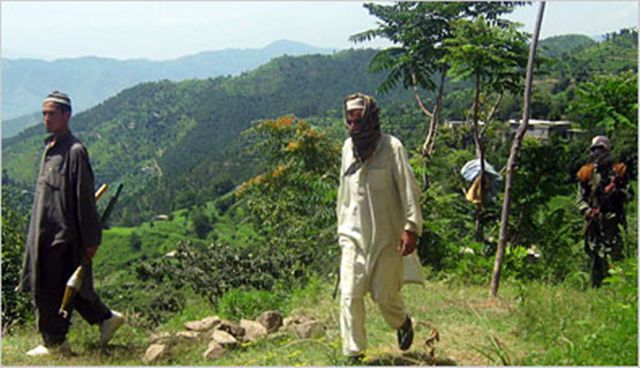
Islamist Militants of the TNSM Plan Return to Pakistan’s Swat Valley
Publication: Terrorism Monitor Volume: 9 Issue: 3
By:

Fear of a Taliban resurgence is rising among the people of the Swat valley, less than one year after the Pakistan army cleared the picturesque area (Dawn [Karachi] Feb 26, 2009). Many in Swat believe the Tehrik-e-Nafaz-e-Shariat-e-Mohammadi (TNSM – Movement for the Enforcement of Islamic Laws) may stage a comeback as soon as the snow melts this spring. Some believe the group will first strengthen its infrastructure and kill all potential resistance before making a move. However, most people think the militants are likely to retake the valley sooner or later if the army does not take action now.
The TNSM sent shockwaves throughout the world in 2009 when it took over the Swat valley and later occupied the adjoining town of Buner, creating fear of its continued march toward Islamabad. Instead of fighting and killing the militants, the Pakistani army chased them out of the valley in the winter of 2009-10, with few TNSM militants choosing to fight back. According to one resident of Mingora, a large number of the TNSM cadres have started coming back to their houses: “They are keeping a low profile at this time. We all know who is who in this town. They very often meet after sunset. It seems they are feeling the pulse of the situation before they strike.” [1] Another resident of Swat confirmed that he had seen some TNSM members smuggling in arms at night:
"The TNSM militants who are coming back to their homes are behaving differently this time. They look subdued so that they do not arouse anybody’s suspicions. They are stockpiling arms and ammunition for some future activity. I have seen one van full of arms off-loaded at [a TNSM member’s] house during the night. We are scared and cannot report it to police or army. We do not even know who is who [in terms of connections to the TNSM] in the police and army." [2]
The intentions of the top TNSM commanders, who remain inaccessible to journalists, are difficult to ascertain. However, the mid-ranking and low-ranking cadres are becoming more accessible to the local media. A mid-level TNSM militant in Malakand told a local journalist that they have been ordered to go back to their homes and wait for orders. The same official said that the group has changed its strategy and wants to work peacefully as a result of the failure of its previous armed jihad. The journalist quoted the TNSM commander as saying; “Our elders have told us to continue our jihad in a peaceful way by winning over the population for now. We have been forbidden to take up arms although we have been asked to store them in the event of a crackdown by the security agencies.” [3]
Other sources, however, have doubts about the peaceful intentions of the TNSM. A local resident related to one of the group’s commanders said that he had been warned of speaking against the TNSM by his relative, as they “are about to rule Swat, Pakistan and the world.” The same resident also said that Taliban members from outside the valley recently visited with Swat militants and they ostensibly held these meetings to plan another insurgency. “They seem to be putting in a lot of planning to avoid failure. They believe if they succeed this time, the army will not be able to dislodge them this time.” [4]
Close analysis of the situation in Swat shows that the TNSM is working on a long term strategy. On the one hand, the group is setting up what can be described as sleeper cells, as the interviews with Swat residents reveal. On the other hand, the militants are killing politicians and members of civil society. In recent months the TNSM and the Taliban have killed more than one politician a week on average, mostly from the governing Awami National Party (ANP). [5] This strategy seems to scare all possible resistance either out of Swat or into submission. According to some officials, the targeted killings of ANP leaders in Karachi, where scores of ANP politicians have been murdered, are likely part of the same strategy. [6]
Some informed officials and politicians in Pakistan say that the army may allow, if not actually encourage, the TNSM and Taliban groups to take over the Swat valley to shift the focus from North Waziristan. The army has been postponing its promised military operation in North Waziristan under various pretexts for some time now. As U.S. pressure grows to go after the Islamist militants there, the Pakistani army is running short of excuses. Swat-II may be a diversion, a theory that has been confirmed by some officials. According to one such civilian official in Islamabad; “As the Western pressure on Pakistan to launch a military operation in North Waziristan grows, the army may be tempted to let Swat fall to the extremists once more to deflect the attention away from Waziristan.” [7] This has been a common tactic used in the past by the Pakistan army in response to Western pressure. It would be difficult for the Americans to keep pressing for an operation in North Waziristan if Islamist militants become entrenched in Swat and threaten Islamabad.
Notes:
1. Interview through a Research Assistant, Swat, December 2009.
2. Ibid.
3. Telephone interview with a local journalist, Malakand, December 2009.
4. Interview through a Research Assistant, Swat, January 2010.
5. Tabulated from Pakistani newspaper reports in the last two months.
6. Telephone interview with a civilian official in Karachi.
7. Telephone interview with an official in Islamabad, December 2009.





